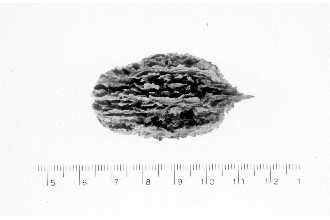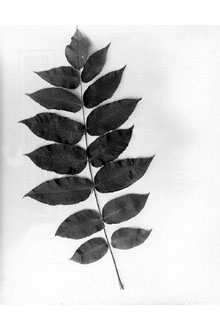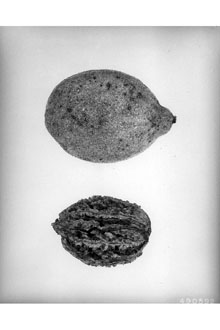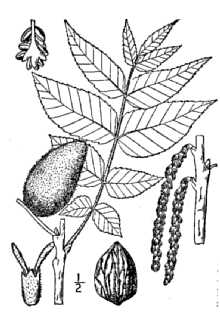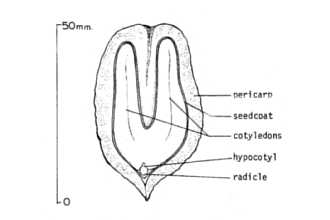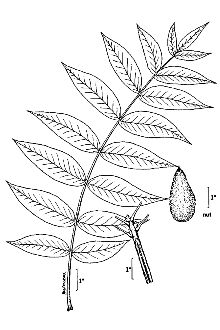Butternut
Scientific Name: Juglans cinerea L.
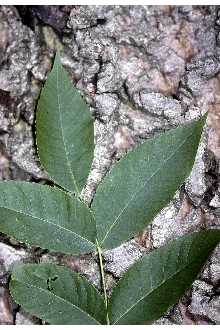
| General Information | |
|---|---|
| Usda Symbol | JUCI |
| Group | Dicot |
| Life Cycle | Perennial |
| Growth Habits | Tree |
| Native Locations | JUCI |
Plant Guide
Uses
Butternut is called "white walnut" because of its light-colored wood, which has a natural golden luster that becomes satin-like when polished. The wood is only moderately hard and saws and carves easily. It has been used for furniture, cabinetry, instrument cases, interior woodwork, including hand-carved wall panels and trim, and church decoration and altars. It is stocked in specialty lumberyards because little is cut annually. Butternuts were often planted close to the house on farmsteads for their use as food. Kernels were used in baking and cultivars have been selected for nut size and for ease of cracking and extracting kernels. They have been popular in New England for making maple-butternut candy. Early settlers used the fruit husks and inner bark to make orange or yellow dye and the root bark provided a laxative. R. Mohlenbrock USDA, NRCS, Wetland Science Institute @ PLANTS
Status
Please consult the PLANTS Web site and your State Department of Natural Resources for this plant’s current status, such as, state noxious status and wetland indicator values.
Description
General: Walnut family (Juglandaceae), Small to medium-sized native trees with stiff upright branches and a wide-spreading crown, the young twigs, stems, and leaflets have hairs sticky-oily to the touch; terminal buds 12-18 mm long; bark brownish-gray, thick, shallowly divided into smooth or scaly plates, Leaves are pinnately compound, the leaflets (7-) 11-17, ovate to lanceolate or oblong-lanceolate, ± symmetric, mostly 5-11cm long, with finely toothed margins, terminal leaflet present, the lower surfaces densely covered with stellate hairs, Flowers are unisexual, female (pistillate) and male (staminate), but on the same tree (the species monoecious), usually not opening simultaneously on any individual tree; male flowers in slender catkins 6-14 cm long, the female flowers in terminal clusters of 6-8 flowers each, Fruit is an oblong-ovoid nut 4-6(-8) cm long, single or in clusters of 2-5, with a hard, thick, deeply furrowed shell enclosed by a thick husk with a sticky-glandular surface, The nuts usually remain on the tree until after leaf fall, The common name refers to the mature nut kernels, which are sweet and oily, like butter, , Use soil moisture sensors to measure the soil moisture of Butternut.
Distribution
Butternut is primarily a species of the northeastern and north-central US and southern Canada from southeastern New Brunswick to Ontario and Quebec; in the US in Minnesota to Missouri and eastward through Tennessee into North Carolina and Virginia, with disjunct outlyers in Arkansas, Mississippi, Alabama, South Carolina, and Georgia. It is uncommon throughout most of its range and formally listed as rare in many of the states in which it occurs. For current distribution, please consult the Plant Profile page for this species on the PLANTS Web site.
Establishment
Adaptation: Butternut is found most frequently in rich woods of coves and stream benches and terraces, on slopes, in the talus of rock ledges, and on other sites with good drainage; at elevations of 0-1000 (-1500) meters. Young trees may grow in considerable competition, but they are shade-intolerant and mature trees must reach the overstory. Flowering occurs from April-June and fruiting from September-October. General: Seed production begins at about 20 years and is optimum from 30-60 years. Good crops can be expected every 2-3 years, with light crops during intervening years. Premature seed losses may result from consumption by insects, birds, and rodents, and a lack of butternut trees in the immediate vicinity may limit pollination and fruit formation. Seeds germinate in the spring after seedfall and a cold period at 20°-30° C. for 90-120 days to break dormancy. Stumps of young butternut trees and saplings are capable of sprouting. The trees are reported to be slow growing and seldom live longer than 75 years.
Management
Butternut canker is killing the species over its whole range. The fungal pathogen (Sirococcus clavigignenti-juglandacearum) apparently was introduced from outside of North America. It was first reported from southwestern Wisconsin in 1967 but is believed to have spread from the southeastern US coastal region, where it first appeared about 40-50 years ago. The Forest Service estimated in 1995 that 77% of the butternuts in the Southeast were dead. The fungus infects trees through buds, leaf scars, and possibly insect wounds and other openings in the bark, rapidly killing small branches. Spores produced on branches are spread by rain, resulting in multiple, perennial stem cankers that eventually girdle and kill infected trees – these do not resprout. The cankered portions should be removed and destroyed and the wounds should be covered with fungicidal paint; leaves that might harbor fungus (brown leaf spot) should be destroyed. A few healthy butternut trees have been found growing among canker-diseased and dying trees and may be resistant. Black walnut apparently is unaffected. A research coalition has been formed to locate surviving trees or populations, characterize sites, identify trees with putative resistance, develop screening methodology for disease resistance, study fungal physiology, and preserve germplasm. Fire easily top-kills butternut and older trees rarely sprout from the root crown or stump. A single hot fire or repeated cool fires can effectively eliminate the species in mixed hardwood stands There is commonly a zone of no-growth or inhibited growth around walnut trees, because they produce a naphthoquinone (juglone) that selectively inhibits growth of associated plants. Juglone is concentrated in root tissue and fruit husks, with lesser amounts in the leaves, catkins, buds, and inner bark. Cultivars, Improved and Selected Materials (and area of origin) Contact your local Natural Resources
Conservation
Service (formerly Soil Conservation Service) office for more information. Look in the phone book under ”United States Government.” The Natural Resources Conservation Service will be listed under the subheading “Department of Agriculture.” These plant materials are readily available from commercial sources. Two hybrids show strong growth and extreme hardiness and produce nuts similar to the butternut in clusters of 10-15. Juglans cinerea X J. regia = Juglans X quadrangulata Juglans cinerea X J. ailantifolia = Juglans X bixbii
References
Anderson, R.L. & L.A. LaMadeleine 1978. The distribution of butternut decline in the eastern United States. USDA, Forest Service, Forest Survey Report S-3-78. Northeastern Area State and Private Forestry, Broomall, Pennsylvania. Black, W.M. & D. Neely 1978. Relative resistance of Juglans species and hybrids to walnut anthracnose. Plant Disease Rep. 62:497-499. Coladonato, M. 1991. Juglans cinerea. IN: W.C. Fischer (compiler). The Fire Effects Information System [Data base]. U.S.D.A., Forest Service, Intermountain Research Station, Intermountain Fire Sciences Laboratory, Missoula, Montana. <http://www.fs.fed.us/database/feis/> Felter, H.W. & J.U. Lloyd 1998. Juglans (U. S. P.)—Juglans. King's American Dispensatory. <http://metalab.unc.edu/herbmed/eclectic/kings/juglans-cine.html> Furnier, G.R., A.M. Stolz, R.M. Mustaphi, & M.E. Ostry 1999. Genetic evidence that butternut canker was recently introduced into North America. Canad. J. Bot. 77:783-785. <http://www.cisti.nrc.ca/cisti/journals/cjb/b99-013.html> Ostry, M.E., M.E. Mielke, & D.D. Skilling 1994. Butternut – strategies for managing a threatened tree. Gen. Tech. Rep. NC-165. USDA Forest Service, North Central Forest Experiment Station. St. Paul, Minnesota. Ostry, M.E., M.E. Mielke, & R.L. Anderson 2000. How to identify butternut canker and manage butternut trees. USDA, Forest Service, North Central Forest Experiment Station, Northeastern Area. <http://willow.ncfes.umn.edu/ht_but/ht_but.htm> Rink, G. 1990. Juglans cinerea L. Butternut. Pp. 386-390, IN: R.M. Burns and B.H. Honkala. Silvics of North America. Volume 2. Hardwoods. USDA, Forest Service Agric. Handbook 654, Washington, D.C. <http://willow.ncfes.umn.edu/silvics_manual/Table_of_contents.htm> Schlarbaum, S.E., F. Hebard, P.C. Spaine, & J.C. Kamalay 2000. Three American tragedies: chestnut blight, butternut canker, and Dutch elm disease. <http://webriver.com/tn-eppc/symposium/schlarba.htm> Stanford, A.M., R. Harden, & C.R. Parks 2000. Phylogeny and biogeography of Juglans (Juglandaceae) based on ITS sequence data. Amer. J. Bot. 87:872-882. USDA, NRCS 1993. Northeast wetland flora: Field office guide to plant species. Wetland Science Institute, Laurel, Maryland. Whittemore, A.T. & D.E. Stone 1997. Juglans. Pp. 425-428, IN: Flora of North America, North of Mexico. Vol. 3. Oxford Univ. Press, New York. <http://hua.huh.harvard.edu/cgi-bin/Flora/flora.pl?FLORA_ID=12395>
Plant Traits
Growth Requirements
| Temperature, Minimum (°F) | -33 |
|---|---|
| Adapted to Coarse Textured Soils | Yes |
| Adapted to Fine Textured Soils | No |
| Adapted to Medium Textured Soils | Yes |
| Anaerobic Tolerance | None |
| CaCO3 Tolerance | None |
| Cold Stratification Required | Yes |
| Drought Tolerance | Low |
| Fertility Requirement | Medium |
| Fire Tolerance | Low |
| Frost Free Days, Minimum | 105 |
| Hedge Tolerance | Low |
| Moisture Use | Medium |
| pH, Maximum | 7.0 |
| pH, Minimum | 6.0 |
| Planting Density per Acre, Maxim | 800 |
| Planting Density per Acre, Minim | 100 |
| Precipitation, Maximum | 80 |
| Precipitation, Minimum | 25 |
| Root Depth, Minimum (inches) | 40 |
| Salinity Tolerance | None |
| Shade Tolerance | Intolerant |
Morphology/Physiology
| Bloat | None |
|---|---|
| Toxicity | Slight |
| Resprout Ability | Yes |
| Shape and Orientation | Erect |
| Active Growth Period | Spring and Summer |
| C:N Ratio | High |
| Coppice Potential | Yes |
| Fall Conspicuous | Yes |
| Fire Resistant | No |
| Flower Color | Green |
| Flower Conspicuous | No |
| Foliage Color | Green |
| Foliage Porosity Summer | Moderate |
| Foliage Porosity Winter | Porous |
| Foliage Texture | Coarse |
| Fruit/Seed Conspicuous | Yes |
| Nitrogen Fixation | None |
| Low Growing Grass | No |
| Lifespan | Short |
| Leaf Retention | No |
| Known Allelopath | Yes |
| Height, Mature (feet) | 80.0 |
| Height at 20 Years, Maximum (fee | 20 |
| Growth Rate | Rapid |
| Growth Form | Single Stem |
| Fruit/Seed Color | Brown |
Reproduction
| Vegetative Spread Rate | None |
|---|---|
| Small Grain | No |
| Seedling Vigor | High |
| Seed Spread Rate | Slow |
| Fruit/Seed Period End | Winter |
| Seed per Pound | 30 |
| Propagated by Tubers | No |
| Propagated by Sprigs | No |
| Propagated by Sod | No |
| Propagated by Seed | Yes |
| Propagated by Corm | No |
| Propagated by Container | Yes |
| Propagated by Bulb | No |
| Propagated by Bare Root | Yes |
| Fruit/Seed Persistence | Yes |
| Fruit/Seed Period Begin | Fall |
| Fruit/Seed Abundance | Medium |
| Commercial Availability | Routinely Available |
| Bloom Period | Late Spring |
| Propagated by Cuttings | No |
Suitability/Use
| Veneer Product | Yes |
|---|---|
| Pulpwood Product | Yes |
| Post Product | Yes |
| Palatable Human | Yes |
| Palatable Graze Animal | Low |
| Palatable Browse Animal | Low |
| Nursery Stock Product | Yes |
| Naval Store Product | No |
| Lumber Product | Yes |
| Fuelwood Product | High |
| Fodder Product | No |
| Christmas Tree Product | No |
| Berry/Nut/Seed Product | Yes |

